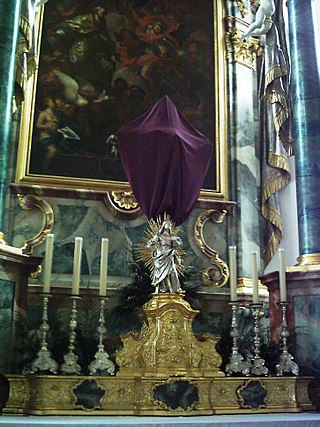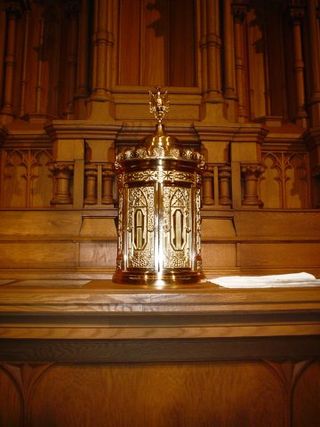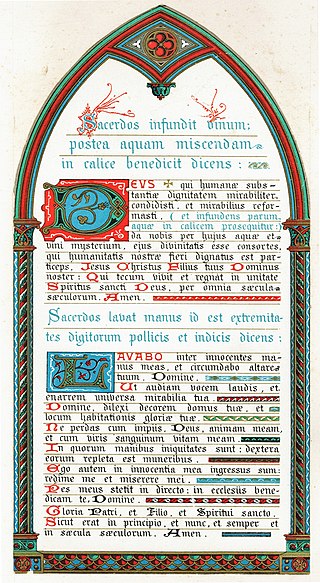This article relies largely or entirely on a single source .(December 2023) |

Manuterge is the name given by the Roman Catholic Church to the towel used by the priest when engaged liturgically. [1]
This article relies largely or entirely on a single source .(December 2023) |

Manuterge is the name given by the Roman Catholic Church to the towel used by the priest when engaged liturgically. [1]
There are two kinds of manuterges. One serves the needs of the sacristy. The priest uses this at the washing of hands before mass, before distributing Communion outside of Mass, and before administering baptism. It can also be used for drying the hands after they have been washed on occasions not prescribed by the rubrics, but still customary after Mass. There are no prescriptions as to material and form for the towel used in the sacristy. It is usual to have it hanging over a roller, the two ends being sewn together so as to make it into a circular band. The custom of washing the hands before Mass may date from Early Christian tradition since the ceremony is expressly mentioned in the sacramentaries of the ninth and tenth centuries.
The other manuterge is used in the Mass for drying both the hands at the Lavabo, an action performed by the priest after the Offertory as he recites the psalm, "Lavabo", and also by the bishop before the Offertory and after the Communion. It is kept on the credence table with the finger-bowl and cruets. There are no ecclesiastical regulations regarding the form and material of this manuterge. The towel, which is used after the Offertory during the recital of the psalm "Lavabo", is usually small (18 in. by 14 in.), only the points of the thumb and two fingers, and not the whole hand, being usually washed. It usually has lace or embroidery at the ends.

In Christianity, ablution is a prescribed washing of part or all of the body or possessions, such as clothing or ceremonial objects, with the intent of purification or dedication. In Christianity, both baptism and footwashing are forms of ablution. Prior to praying the canonical hours at seven fixed prayer times, Oriental Orthodox Christians wash their hands and face. In liturgical churches, ablution can refer to purifying fingers or vessels related to the Eucharist. In the New Testament, washing also occurs in reference to rites of Judaism part of the action of a healing by Jesus, the preparation of a body for burial, the washing of nets by fishermen, a person's personal washing of the face to appear in public, the cleansing of an injured person's wounds, Pontius Pilate's washing of his hands as a symbolic claim of innocence and foot washing, which is a rite within the Christian Churches. According to the Gospel of Matthew, Pontius Pilate declared himself innocent of the blood of Jesus by washing his hands. This act of Pilate may not, however, have been borrowed from the custom of the Jews. The same practice was common among the Greeks and Romans.

Maundy, or Washing of the Saints' Feet, Washing of the Feet, or Pedelavium or Pedilavium, is a religious rite observed by various Christian denominations. The word mandatum is the first word of the Latin Biblical quotation sung at the ceremony of the washing of the feet: "Mandatum novum do vobis ut diligatis invicem sicut dilexi vos", from the text of John 13:34 in the Vulgate. The ceremony commemorates the commandment of Christ that his disciples should emulate his loving humility in the washing of the feet. The medieval Latin term mandatum, came to apply to the rite of foot-washing on the Thursday preceding Easter Sunday, known in English as "Maundy Thursday" since at least 1530.

A Pontifical High Mass, also called Solemn Pontifical Mass, is a Solemn or High Mass celebrated by a bishop using certain prescribed ceremonies. Although in modern English the word "pontifical" is almost exclusively associated with the pope, any bishop may be properly called a pontiff. Thus, the celebrant of a Pontifical High Mass may be the pope, any bishop or any other prelate who is allowed to wear pontificals.

A lavabo is a device used to provide water for the washing of hands. It consists normally of a ewer or container of some kind to pour water, and a bowl to catch the water as it falls off the hands. In ecclesiastical usage it refers to all of: the basin in which the priest washes their hands; the ritual that surrounds this action in the Catholic Mass; and the architectural feature or fitting where a basin or place for one is recessed into the side wall of the sanctuary, or projects from it. If this last includes or included a drain, it is a piscina used for washing the church plate and other fittings, though the terms are often confused. In secular usage, it is an obsolete term for any sink or basin for washing hands, especially in a lavatory.

The proper is a part of the Christian liturgy that varies according to the date, either representing an observance within the liturgical year, or of a particular saint or significant event. The term is used in contrast to the ordinary, which is that part of the liturgy that is reasonably constant, or at least selected without regard to date, or to the common, which contains those parts of the liturgy that are common to an entire category of saints, such as apostles or martyrs.

A paten or diskos is a small plate, used during the Mass. It is generally used during the liturgy itself, while the reserved sacrament are stored in the tabernacle in a ciborium.

An altar cloth is used in the Christian liturgy to cover the altar. It serves as a sign of reverence as well as a decoration and a protection of the altar and the sacred vessels. In the orthodox churches it is covered by the antimension, which also contains the relics of saints.

Passiontide is a name for the last two weeks of Lent, beginning on the Fifth Sunday of Lent, long celebrated as Passion Sunday, and continuing through Lazarus Saturday. It commemorates the suffering of Christ. The second week of Passiontide is Holy Week, ending on Holy Saturday.

A piscina is a shallow basin placed near the altar of a church, or else in the vestry or sacristy, used for washing the communion vessels. The sacrarium is the drain itself. Lutherans and Anglicans usually refer to the basin, calling it a piscina. For Catholics and Lutherans, a sacrarium is "special sink used for the reverent disposal of sacred substances. This sink has a cover, a basin, and a special pipe and drain that empty directly into the earth, rather than into the sewer system". Precious or sacred items are disposed of, when possible, by returning them to the ground. They are in some cases used to dispose of materials used in the sacraments and water from liturgical ablutions. They are found in Catholic, Anglican, and Lutheran churches, and a similar vessel is used in Eastern Orthodox churches.

The diaconicon is, in Eastern Orthodox and Eastern Catholic Churches, the name given to a chamber on the south side of the central apse of the church, where the vestments, books, etc., that are used in the Divine Services of the church are kept. Diaconicon and prothesis are collectively known as pastophoria.
The Use of York or York Rite was a liturgical use of the Roman Rite – itself a Latin liturgical rite – practised in part of northern England, prior to the reign of Henry VIII. During Henry's reign the Use of York was suppressed in favour of the Use of Sarum, developed at Salisbury Cathedral, followed by the Book of Common Prayer. "Use" denotes the special liturgical customs which prevailed in a particular diocese or group of dioceses; it is one of the medieval English uses, together with the Use of Sarum, the Use of Hereford, and the Use of Bangor.

During the Mass of the Faithful, the second part of the Mass, the elements of bread and wine are considered to have been changed into the veritable Body and Blood of Jesus Christ. The manner in which this occurs is referred to by the term transubstantiation, a theory of St. Thomas Aquinas, in the Roman Catholic Church. Members of the Orthodox, Anglican, and Lutheran communions also believe that Jesus Christ is really and truly present in the bread and wine, but they believe that the way in which this occurs must forever remain a sacred mystery. In many Christian churches some portion of the consecrated elements is set aside and reserved after the reception of Communion and referred to as the reserved sacrament. The reserved sacrament is usually stored in a tabernacle, a locked cabinet made of precious materials and usually located on, above, or near the high altar. In Western Christianity usually only the Host, from Latin: hostia, meaning "victim", is reserved, except where wine might be kept for the sick who cannot consume a host.
The Secret is a prayer said in a low voice by the priest or bishop during religious services.
Oremus is the invitation to pray, said before short prayers in the Catholic Mass and the Lutheran Divine Service, as well as other Western liturgies.

Altar cards are three cards placed on the altar during the Tridentine Mass. They contain certain prayers that the priest must say during the Mass, and their only purpose is as a memory aid, although they are usually very beautifully decorated.

The episcopal gloves or pontifical gloves are a Roman Catholic pontifical vestment worn a by bishop when celebrating Solemn Pontifical Mass. They are worn from the beginning of the Mass until the offertory, when they are removed. They can be elaborately embroidered and generally match the liturgical color of the Mass. They are not worn for Good Friday or Requiem Masses. While normally reserved for bishops, other prelates entitled to use pontificals, including abbots, may also use them without a special papal privilege.

The Mass of the Lord's Supper, also known as A Service of Worship for Maundy Thursday, is a Holy Week service celebrated on the evening of Maundy Thursday. It inaugurates the Easter Triduum, and commemorates the Last Supper of Jesus with his disciples, more explicitly than other celebrations of the Mass.
The Missa sicca was a form of Catholic devotion used in the medieval Catholic Church when a full Mass could not be said, such as for funerals or marriages which were served in the afternoon after a priest had already said Mass earlier that morning. It consisted of all components the Mass except the Offertory, Consecration and Communion.

A credence table is a small side table in the sanctuary of a Christian church which is used in the celebration of the Eucharist..

The Stripping of the Altar or the Stripping of the Chancel is a ceremony carried out in many Catholic, Lutheran, Methodist, and Anglican churches on Maundy Thursday.
![]() This article incorporates text from a publication now in the public domain : Herbermann, Charles, ed. (1913). "Manuterge". Catholic Encyclopedia . New York: Robert Appleton Company.
This article incorporates text from a publication now in the public domain : Herbermann, Charles, ed. (1913). "Manuterge". Catholic Encyclopedia . New York: Robert Appleton Company.